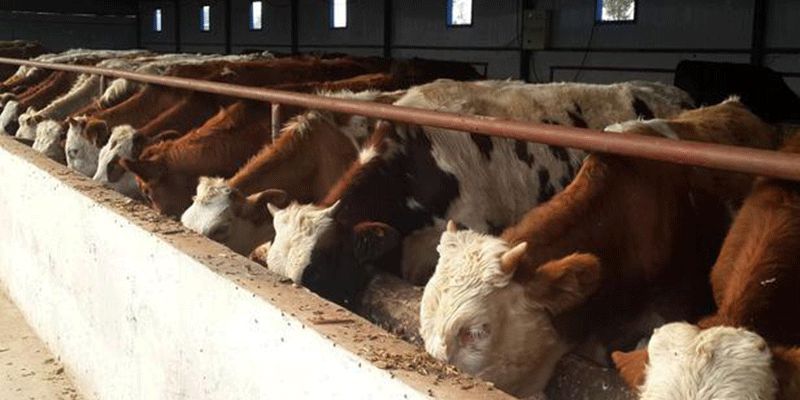Ovarian cysts are a common reproductive organ disease in cattle, classified clinically into follicular cysts and corpus luteum cysts. Dairy cows with disrupted estrous cycles often respond poorly to conventional drug treatments. In cases of follicular cysts, the individual estrous period is prolonged, and severe cases may exhibit ‘male-seeking mania’ symptoms, leading to prolonged infertility despite repeated breeding attempts. Some animals may develop fractures due to prolonged mounting behaviour. Cows with corpus luteum cysts often exhibit prolonged anestrous periods postpartum. Cows with ovarian cysts lose normal reproductive function, severely impacting the economic efficiency of cattle farming. Ovarian cysts are one of the primary causes of reproductive disorders in dairy cows, resulting in annual losses of up to 300–500 USD per head on farms. Traditional hormone therapy has limitations such as high recurrence rates and low conception rates. In contrast, ultrasound-guided puncture technology, with its advantages of precision, minimally invasive procedures, and low cost, is increasingly becoming the preferred solution in the international livestock industry. This article will detail operational guidelines and introduce clinical application experiences from livestock powerhouses such as Australia, the United Kingdom, and New Zealand.
1 Causes and Diagnosis
1.1 Causes
Insufficient vitamins in feed, gonadal degeneration; delayed ovulation due to LH deficiency in the body; improper use of FSH and PMSG, among other factors, can all lead to ovarian cysts.
1.2 Diagnosis
During rectal examination of animals with ovarian cysts, enlarged ovaries and cystic lesions on the ovaries can be observed. Individual cystic lesions have smooth surfaces and exhibit a fluctuant sensation upon palpation. Affected animals typically exhibit disrupted estrous cycles, prolonged estrous periods, or prolonged anestrous periods postpartum.
1.3 Technical Principles and Core Advantages
Precise Minimally Invasive Treatment Mechanism
Under real-time ultrasound guidance, a needle is used to precisely locate the cyst cavity. After aspirating the cyst fluid, a sclerosing agent (such as polyethylene glycol or anhydrous ethanol) is injected to destroy the secretory cells of the cyst wall and promote tissue adhesion and closure. This technology originated from mature applications in human medicine (e.g., ovarian cyst treatment 3611) and has been extended to veterinary clinical practice, achieving the effect of ‘one-needle ablation.’
Advantages Over Traditional Therapies
Minimal trauma: Only a 16-18G needle (puncture site <1mm) is required, avoiding the risks associated with abdominal surgery;
Rapid recovery: Cattle can resume feeding within 24 hours post-surgery and return to the breeding herd within 3-5 days;
Cost reduction: Over 60% reduction in costs compared to laparoscopic surgery (UK AHDB data);
Preservation of fertility: Avoids damage to ovarian tissue, maintaining normal hormone secretion
2 Standardised Operating Procedures
2.1 Preoperative Preparation
Cattle assessment: Confirm cyst characteristics via transrectal ultrasound (diameter ≥5 cm, persisting for >21 days) and rule out pregnancy 1012;
Instrument sterilisation: Sterile isolation of the cattle ultrasound probe; use disposable 18G PTC needles for puncture (refer to human medical standards 28);
Sedation and analgesia: New Zealand recommends intravenous injection of celazepam (0.03 mg/kg) + local infiltration with lidocaine.
Intraoperative procedure
Positioning and access:
Cattle standing in restraint, needle insertion via the rectum or abdominal wall (avoiding the uterus and blood vessels);
Australian experience: Prefer the rectal approach; needle accuracy reaches 99% when the probe is within 5 cm of the ovary¹⁷.
2.2 Key steps:
graph TD
A[Ultrasound localization of the cyst] –> B[Needle directly reaches the centre of the cyst cavity]
B –> C[Aspirate all cyst fluid under negative pressure]
C –> D[Rinse with saline solution three times]
D –> E[Inject sclerosing agent (one-third of cyst fluid volume)]
E –> F[Withhold for five minutes before withdrawal]
*Note: Sclerosant selection — the UK prefers polyethylene glycol (low irritation), while New Zealand primarily uses anhydrous ethanol (low cost)*
2.3 Postoperative management
Antibiotic prophylaxis to prevent infection (e.g., ceftiofur sodium for 3 days);
Ultrasound follow-up after 14 days to assess closure rate;
Fertility monitoring: Record the first estrus date and conception rate (UK requires inclusion in the farm management system).
Technological advancements driving a revolution in farm reproduction
The success rate of cattle ultrasound-guided puncture therapy highly depends on equipment precision and standardised procedures. Devices such as China’s Dawei portable veterinary ultrasound and cart-mounted veterinary ultrasound, Australia’s FieldVet series, and the UK’s BCF livestock ultrasound are all optimised for puncture scenarios.
Post time: Jun-17-2025




